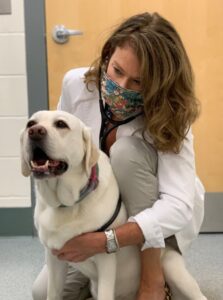-
Adopt
-
Veterinary Care
Services
Client Information
- What to Expect – Angell Boston
- Client Rights and Responsibilities
- Payments / Financial Assistance
- Pharmacy
- Client Policies
- Our Doctors
- Grief Support / Counseling
- Directions and Parking
- Helpful “How-to” Pet Care
Online Payments
Referrals
- Referral Forms/Contact
- Direct Connect
- Referring Veterinarian Portal
- Clinical Articles
- Partners in Care Newsletter
CE, Internships & Alumni Info
CE Seminar Schedule
Emergency: Boston
Emergency: Waltham
Poison Control Hotline
-
Programs & Resources
- Careers
-
Donate Now
 By Jessica Hamilton Seid, DVM
By Jessica Hamilton Seid, DVM![]()
angell.org/emergency
emergency@angell.org
781-902-8400
What are Seizures?
The definition of a seizure is the clinical manifestation of abnormal electrical activity in the brain. Seizures are the most common neurologic disorder seen in dogs and are usually classified as either generalized or partial. Generalized seizures, also called grand mal seizures, are characterized by diffuse motor activity with loss of consciousness – which can include, but is not limited to, paddling of limbs, rigid limbs, hypersalivation, urination, defecation, mouth chomping, and shaking/tremoring. Partial seizures, also called focal seizures, are characterized by activity primarily affecting a specific part of the body (facial or limb twitching, mouth chomping) and does not involve loss of consciousness.
Causes of Seizures
 When we think about underlying causes of seizures, we like to place them into two main categories: intracranial (inside the brain) versus extracranial (outside the brain). Common intracranial causes of seizures include vascular event (stroke), encephalitis (infectious or inflammatory causes), cancer (brain tumor), structural abnormality, head trauma, or idiopathic epilepsy (no identified underlying causes). Common extracranial causes of seizures include metabolic diseases (i.e. liver failure, hypoglycemia, hypocalcemia) and toxin ingestion.
When we think about underlying causes of seizures, we like to place them into two main categories: intracranial (inside the brain) versus extracranial (outside the brain). Common intracranial causes of seizures include vascular event (stroke), encephalitis (infectious or inflammatory causes), cancer (brain tumor), structural abnormality, head trauma, or idiopathic epilepsy (no identified underlying causes). Common extracranial causes of seizures include metabolic diseases (i.e. liver failure, hypoglycemia, hypocalcemia) and toxin ingestion.
Idiopathic epilepsy is a common cause of seizures in young to middle aged dogs and refers to seizures that have an unknown underlying cause. Unfortunately, epilepsy is what is called a diagnosis of exclusion, meaning that to truly diagnose it, evaluation for all other potential causes of seizures must be performed and ruled out. In some instances a diagnosis of epilepsy is presumed if there are no apparent underlying diseases and the dog is in the correct age range.
In geriatric dogs with development of first-time seizures, the top concerns for a cause are unfortunately usually related to underlying pathology in the brain, such as a brain tumor or vascular/stroke event.
Stages of a Seizure
Prodome: The initial stage of a seizure where dogs can experience a variety of behaviors like anxiety, clinginess, or irritability prior to the start of a seizure.
Pre-ictal: The beginning of a seizure where a dog may exhibit a vacant stare, disconnection with the owner, and may start to slowly arch the neck and head.
Ictal: The active seizure period, which is normally characterized by tonic and clonic phases, including loss of consciousness, rigid limbs, erratic breathing, loss of bowel or bladder control, chewing mouth movements, hypersalivation, and/or paddling of limbs.
Post-Ictal: The period following a seizure which can be characterized by abnormal mentation, pacing, ataxia, temporary blindness and sometimes aggression.
What to do if Your Dog has a Seizure
Witnessing a seizure at home can be very stressful, but know that a seizure is not painful for the dog and when they recover, they do not know what has just happened. The most important thing to do during a seizure is to protect your dog and yourself from being injured. You can do this by making sure there are no stairs they can fall down or sharp furniture corners to bump into and by keeping yourself safe by using a thick blanket or towel to gently move them or to pad an area to keep them safe if needed. It is also important to stay away from their face/mouth to prevent getting bit during a seizure as they do not know what they are doing and mouth chomping/chewing commonly occurs during a seizure. If you are able to, timing the length of the seizure and noting what happens during a seizure can be helpful information for your veterinarian. Taking a recording can be an easy way for many dog owners to document the length and events that occur during a seizure.
If your dog experiences a cluster seizure episode, which is 2 or more seizures in a 24-hour period, or is in status epilepticus, which is characterized by continuous seizure activity lasting 5 minutes or longer, or repeated seizures with a failure to return to normal in between, then they need to be seen on an emergency basis by a veterinarian. It is also recommended that any dog experiencing a first-time seizure be evaluated by a veterinarian.
Diagnosis, Treatment, and Monitoring
When a pet comes in for a first-time seizure it is important to investigate for an underlying cause of the seizure, like low blood sugar or calcium levels, because if one is found treatments can be initiated. Baseline blood work (complete blood count, chemistry panel, thyroid level), urinalysis and a blood pressure are normally performed. Chest radiographs (x-rays) and/or additional bloodwork to evaluate liver function (serum bile acids) may also be recommended based on the dog’s blood work and/or history. If initial diagnostics are normal then further evaluation with a veterinary neurologist and pursuing additional testing, such as additional bloodwork, an MRI or spinal fluid analysis may be needed to obtain a diagnosis. Medications and treatments are tailored to the diagnosis. If no cause of the seizures is found then a diagnosis of idiopathic epilepsy can be made.
Normally, medication for seizure management is started if a dog is having emergent seizures, i.e., a cluster event or status epilepticus, or if a dog is having more than one seizure every 4-6 weeks. There are numerous options for oral medications for seizure management. Some common anti-seizure medications include Keppra (Levetiracetam), Zonisamide, and Phenobarbital. Some dogs may need to be on more than one medication to help effectively control their seizures. The goal with starting medication for seizure control in dogs is management of the seizures to an acceptable frequency and duration, not to eliminate the occurrence of seizures entirely, as this is not a practical expectation.
After starting on anti-seizure medications or even if the seizures are infrequent and starting medication is not indicated yet, follow-up and monitoring with a veterinarian or veterinary neurologist is very important. Keeping a seizure journal and noting the day, time, length and characteristics of each seizure is very important for seizure monitoring and is helpful in guiding the veterinarian in the appropriate monitoring, diagnostics and therapies for each individual dog and owner.